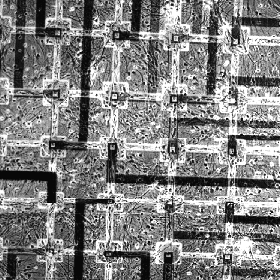
![[GlobalNews Home]](../globe.gif)
![[Prev Page]](/images/arrow-left.gif)
![[Next Page]](/images/arrow-right.gif)
I came to NTT, originally, from a background in physiology at Cambridge University and more recently, from the Tokyo Metropolitan Institute of Neurosciences (TMIN), where I spent three years researching synaptic connections between biological neurons from the standpoint of basic biology. My interest was in the technique of the Kawana Group for making large planar arrays of electrodes by lithographic patterning, and moreover, for guiding neurons to specific electrodes using the substrate morphology. A further aim was to investigate ways of multisite optical recording of activity, using a very fast camera and fluorescent indicator dyes. I began to work on networks of cultured cortex neurons (grown up from embryonic rats). At first, the activity that we observed was weak and seemingly random. However, we soon found that when the network was excited nonspecifically by lowering the bathing magnesium ion concentration, periodic bursts of firing could be observed by patch-clamping. We decided to focus on this very structured and stable behavior, and to try to explain it. Using optical recording with a new fast camera from Olympus, for which I spent a good fraction of my time writing computer programs, I found that the bursts of impulse firing of the cells corresponded to transients in the neuronal calcium ion concentration, and that calcium transients were synchronized between neurons over large areas in the network. Using a combination of the patch-clamp and optical recording, we studied how particular types of synaptic current could sum together and generate the burst firing, and proposed a fairly detailed hypothesis for the mechanism of the burst firing.
I have now returned to the Physiological Laboratory at Cambridge University, where I am a research fellow sponsored by the Wellcome Foundation, for at least the next three years. However, the work that I have described here is still continuing. In Cambridge, I am using the NTT electrode arrays as stimulating devices for more basic investigation of interactions between multiple synaptic inputs in single neurons.
At NTT, the Kawana Group have recently obtained a variety of beautiful results from recording through the multiple sites of the electrode array during burst firing - images of the direction and speed of propagation of activity and its significantly random initiation, as well as long-term changes in the coupling and frequency of bursts by stimulating restricted sites in the network. I (already!) look back with great nostalgia on my years in Tokyo, and send best wishes to all my friends in the International Community at NTT.
Hugh Robinson,
Physiological Laboratory,
Downing St., Cambridge
CB2 3EG, U.K.,
HPCR@phx.cam.ac.uk

![[GlobalNews Home]](../globe.gif)
![[Prev Page]](/images/arrow-left.gif)
![[Next Page]](/images/arrow-right.gif)